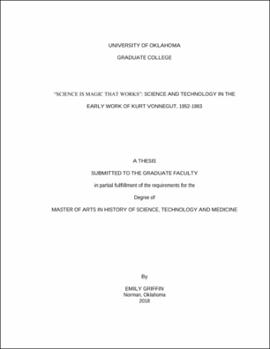| dc.contributor.advisor | Weldon, Stephen | |
| dc.contributor.author | Griffin, Emily | |
| dc.date.accessioned | 2018-05-09T16:18:35Z | |
| dc.date.available | 2018-05-09T16:18:35Z | |
| dc.date.issued | 2018-05-11 | |
| dc.identifier.uri | https://hdl.handle.net/11244/299819 | |
| dc.description.abstract | Kurt Vonnegut’s writing helped to push the boundaries of our conventional understanding of twentieth-century American literature through his inclusion of science fiction themes in many of his works and his poignant discussions of the perils of war. However, it is his work as a critic of science and technology during the Cold War period which helps to complicate a man who so often seems dismissive of human beings. His connection with the General Electric company and his experiences in World War II complicated the views of a man who, for the first twenty years of his life, fully expected to become a scientist. I will be making the argument that in two of Vonnegut’s first novels, Player Piano and Cat’s Cradle, he draws on his ties to GE to critique the structure of corporate science and illustrate the dangers that the creations of these institutions pose, namely that they are addictive and unpredictable. Together, the novels represent the end of work and the end of the world, respectively. | en_US |
| dc.subject | Kurt Vonnegut | en_US |
| dc.subject | Corporate Science | en_US |
| dc.subject | Cold War Science | en_US |
| dc.subject | Automation | en_US |
| dc.title | “SCIENCE IS MAGIC THAT WORKS”: SCIENCE AND TECHNOLOGY IN THE EARLY WORK OF KURT VONNEGUT, 1952-1963 | en_US |
| dc.contributor.committeeMember | Soppelsa, Peter | |
| dc.contributor.committeeMember | Zeigler, James | |
| dc.date.manuscript | 2018-05-09 | |
| dc.thesis.degree | Master of Arts in History of Science, Technology and Medicine | en_US |
| ou.group | College of Arts and Sciences::Department of History of Science | en_US |
